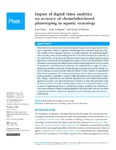Impact of Digital Video Analytics on Accuracy of Chemobehavioural Phenotyping in Aquatic Toxicology

Use this link to cite
http://hdl.handle.net/2183/23993Collections
- Investigación (FIC) [1684]
Metadata
Show full item recordTitle
Impact of Digital Video Analytics on Accuracy of Chemobehavioural Phenotyping in Aquatic ToxicologyDate
2019-08-05Citation
Henry J, Rodriguez A, Wlodkowic D. 2019. Impact of digital video analytics on accuracy of chemobehavioural phenotyping in aquatic toxicology. PeerJ 7:e7367 https://doi.org/10.7717/peerj.7367
Abstract
[Abstract] Chemobehavioural phenotypic analysis using small aquatic model organisms is becoming an important toolbox in aquatic ecotoxicology and neuroactive drug discovery. The analysis of the organisms’ behavior is usually performed by combining digital video recording with animal tracking software. This software detects the organisms in the video frames, and reconstructs their movement trajectory using image processing algorithms. In this work we investigated the impact of video file characteristics, video optimization techniques and differences in animal tracking algorithms on the accuracy of quantitative neurobehavioural endpoints. We employed larval stages of a free-swimming euryhaline crustacean Artemia franciscana,commonly used for marine ecotoxicity testing, as a proxy modelto assess the effects of video analytics on quantitative behavioural parameters. We evaluated parameters such as data processing speed, tracking precision, capability to perform high-throughput batch processing of video files. Using a model toxicant the software algorithms were also finally benchmarked against one another. Our data indicates that variability in video file parameters; such as resolution, frame rate, file containers types, codecs and compression levels, can be a source of experimental biases in behavioural analysis. Similarly, the variability in data outputs between different tracking algorithms should be taken into account when designing standardized behavioral experiments and conducting chemobehavioural phenotyping.
Keywords
Animal behavior
Zoology
Ecotoxicology
Tracking
Video
Toxicity
Phenomics
Zoology
Ecotoxicology
Tracking
Video
Toxicity
Phenomics
Editor version
Rights
Atribución 3.0 España
ISSN
2167-8359
2376-5992
2376-5992






